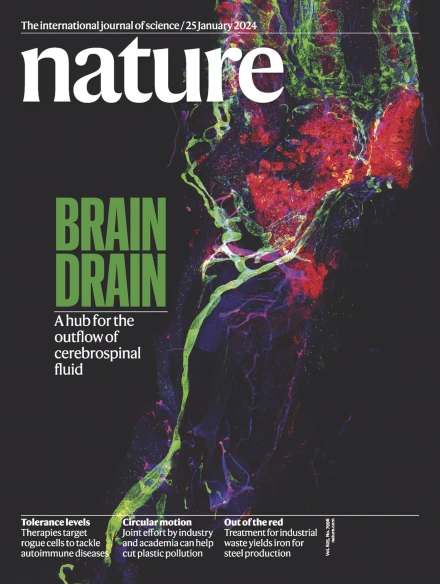Dynamic fibroblast-immune interactions shape recovery after brain injury.
IF 48.5
1区 综合性期刊
Q1 MULTIDISCIPLINARY SCIENCES
引用次数: 0
Abstract
Fibroblasts and immune cells coordinate tissue regeneration and necessary scarring after injury. In the brain, fibroblasts are border-enriched cells whose dynamic molecular states and immune interactions after injury remain unclear1. Here we define the shared fibroblast-immune response to brain injury. Early profibrotic myofibroblasts develop from pre-existing brain fibroblasts and infiltrate brain lesions, orchestrated by fibroblast TGFβ signalling, profibrotic macrophages and microglia, and perilesional glia. Myofibroblasts transition into several late fibroblast states, including lymphocyte-interactive fibroblasts. Interruption of the early myofibroblast state exacerbated sub-acute brain injury, tissue loss and secondary neuroinflammation, with increased mortality in the transient middle cerebral artery occlusion stroke model. Disruption of late lymphocyte-fibroblast niches via selective loss of fibroblast chemokine CXCL12 led to late brain-specific innate inflammation and lymphocyte dispersal with increased IFNγ production. These data indicate the response to brain injury is coordinated by evolving temporal and spatial fibroblast states that limit functional tissue loss and chronic neuroinflammation.动态成纤维细胞-免疫相互作用影响脑损伤后的恢复。
成纤维细胞和免疫细胞协调损伤后的组织再生和必要的瘢痕形成。在大脑中,成纤维细胞是边界富集的细胞,其动态分子状态和损伤后的免疫相互作用尚不清楚。在这里,我们定义了成纤维细胞对脑损伤的共同免疫反应。早期成纤维性肌成纤维细胞由先前存在的脑成纤维细胞发育而来,并浸润脑病变,由成纤维细胞TGFβ信号、成纤维巨噬细胞和小胶质细胞以及病灶周围胶质细胞精心策划。肌成纤维细胞转变为几种晚期成纤维细胞状态,包括淋巴细胞相互作用成纤维细胞。早期肌成纤维细胞状态的中断加重了亚急性脑损伤、组织损失和继发性神经炎症,并增加了短暂性大脑中动脉闭塞性卒中模型的死亡率。通过选择性丧失成纤维细胞趋化因子CXCL12破坏晚期淋巴细胞-成纤维细胞壁龛,导致晚期脑特异性先天炎症和淋巴细胞分散,同时增加IFNγ的产生。这些数据表明,对脑损伤的反应是通过进化的时间和空间成纤维细胞状态来协调的,这些状态限制了功能性组织损失和慢性神经炎症。
本文章由计算机程序翻译,如有差异,请以英文原文为准。
求助全文
约1分钟内获得全文
求助全文
来源期刊

Nature
综合性期刊-综合性期刊
CiteScore
90.00
自引率
1.20%
发文量
3652
审稿时长
3 months
期刊介绍:
Nature is a prestigious international journal that publishes peer-reviewed research in various scientific and technological fields. The selection of articles is based on criteria such as originality, importance, interdisciplinary relevance, timeliness, accessibility, elegance, and surprising conclusions. In addition to showcasing significant scientific advances, Nature delivers rapid, authoritative, insightful news, and interpretation of current and upcoming trends impacting science, scientists, and the broader public. The journal serves a dual purpose: firstly, to promptly share noteworthy scientific advances and foster discussions among scientists, and secondly, to ensure the swift dissemination of scientific results globally, emphasizing their significance for knowledge, culture, and daily life.
 求助内容:
求助内容: 应助结果提醒方式:
应助结果提醒方式:


